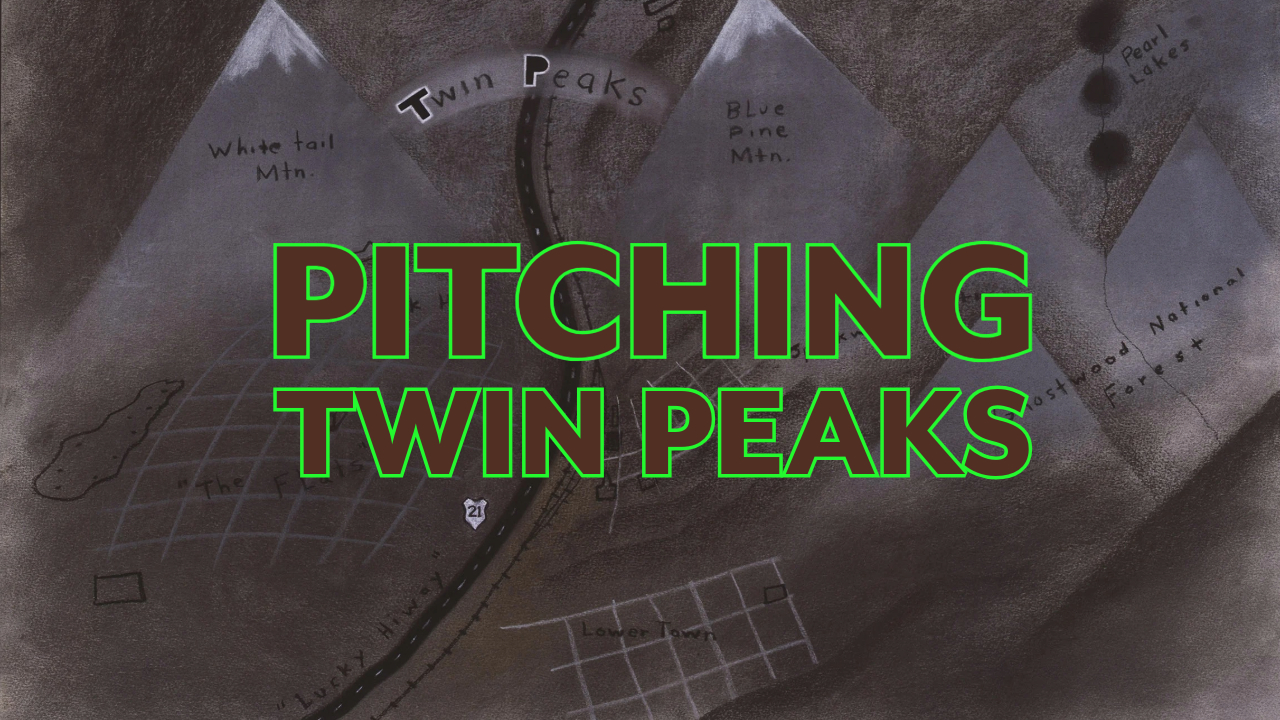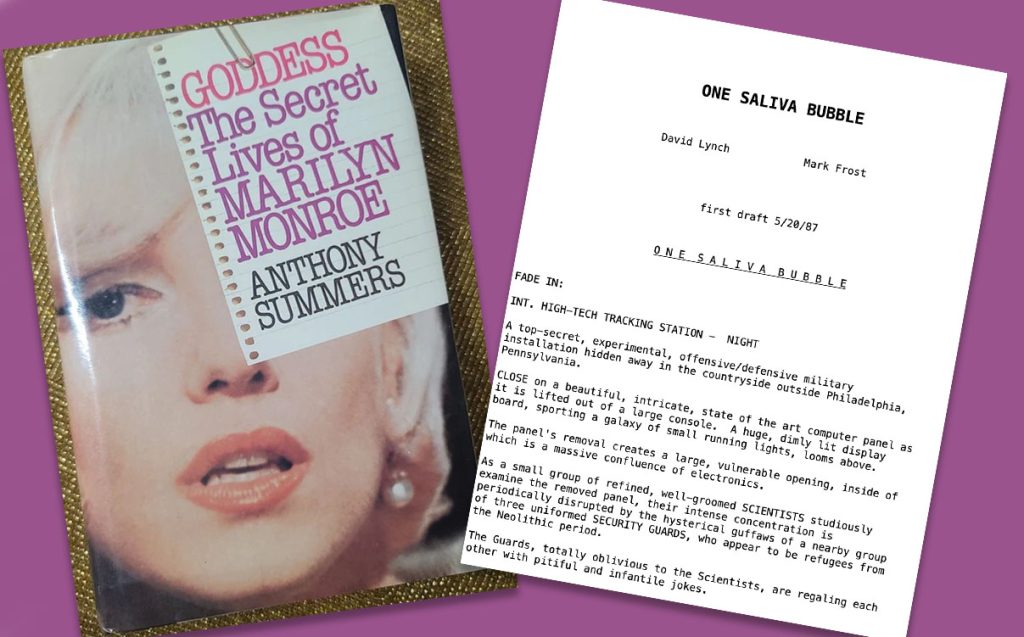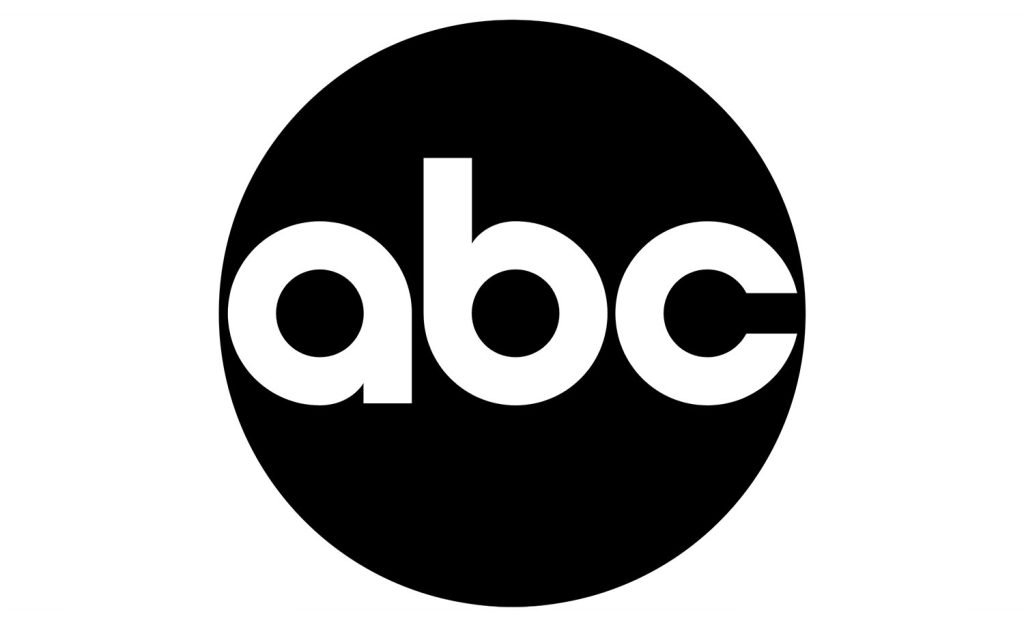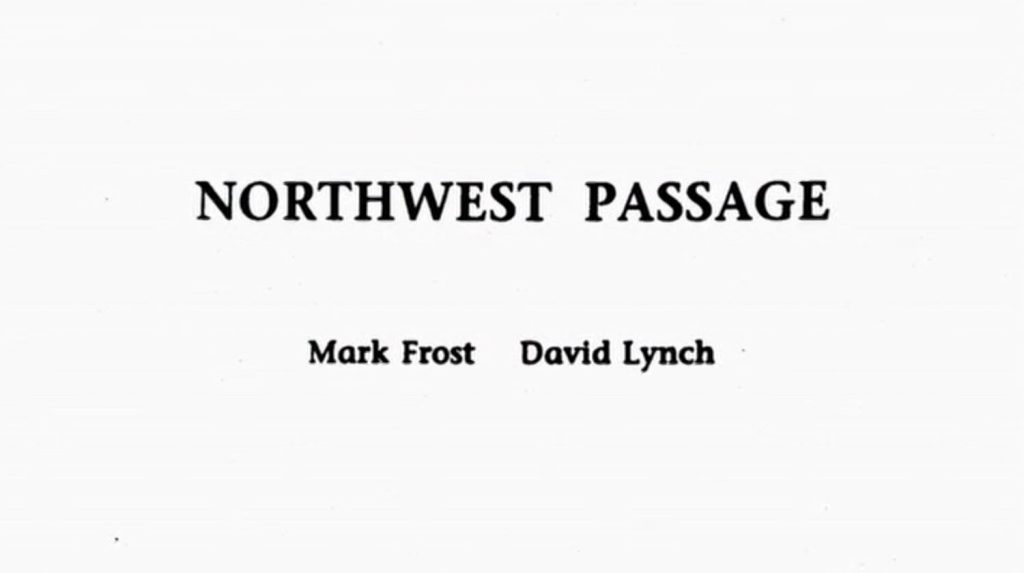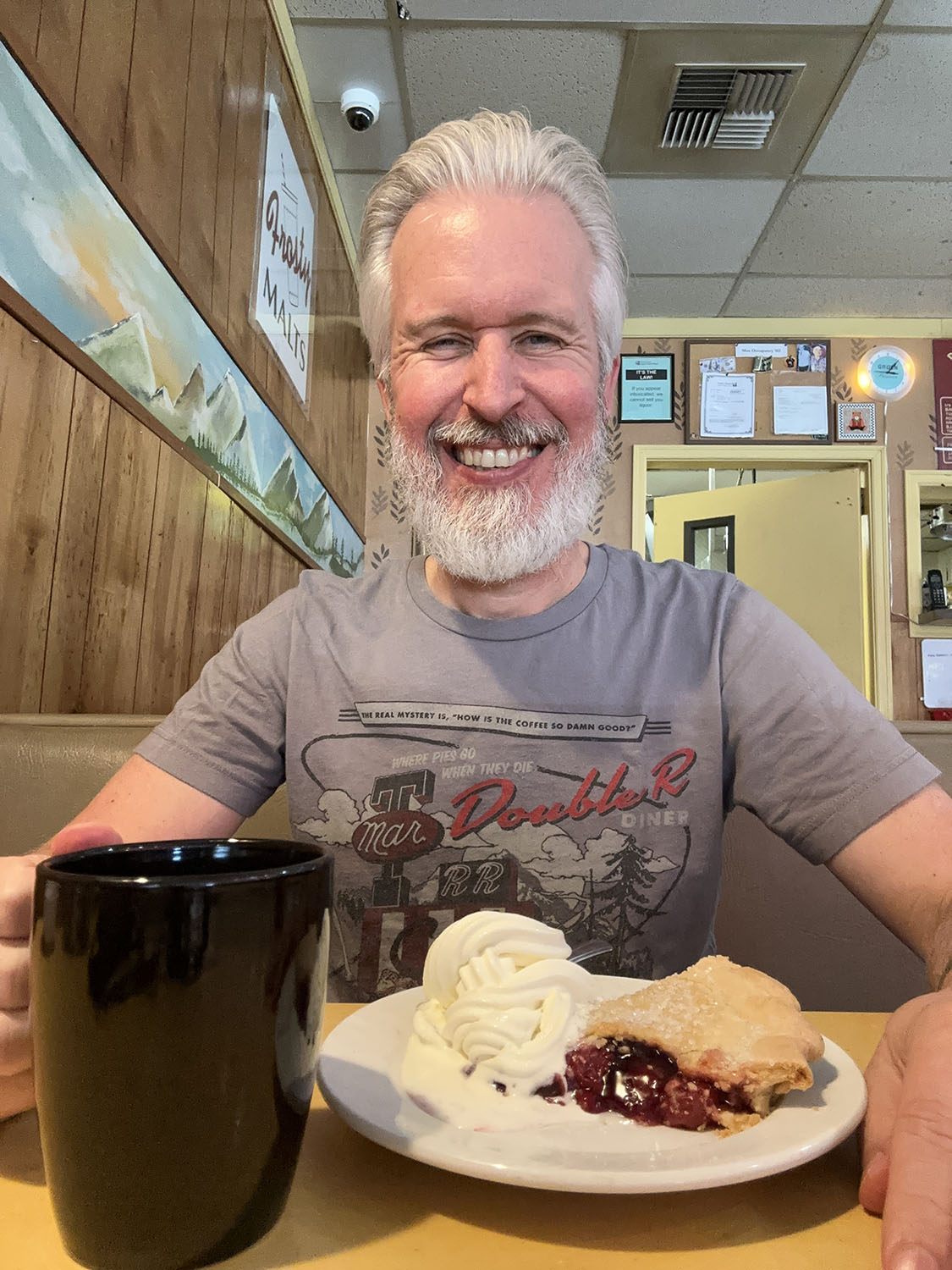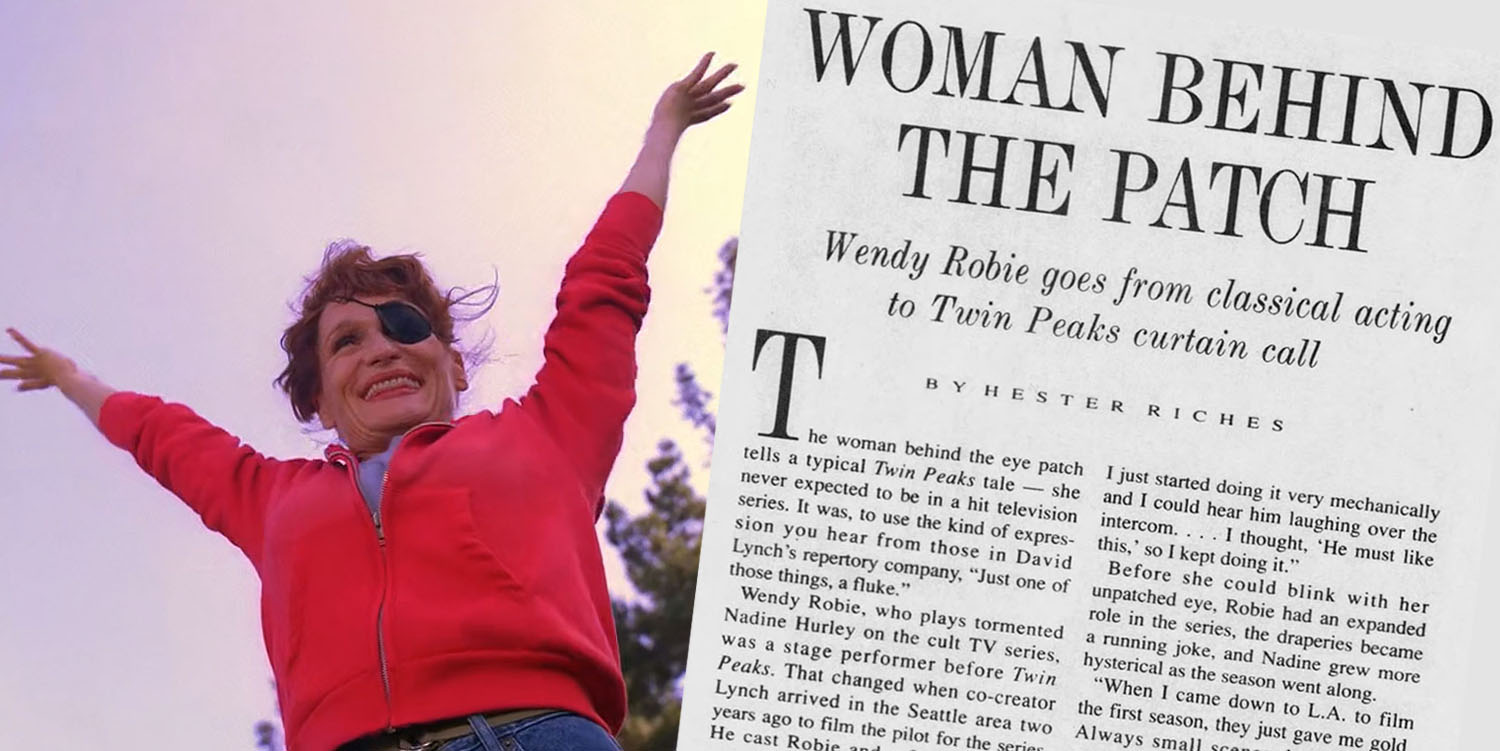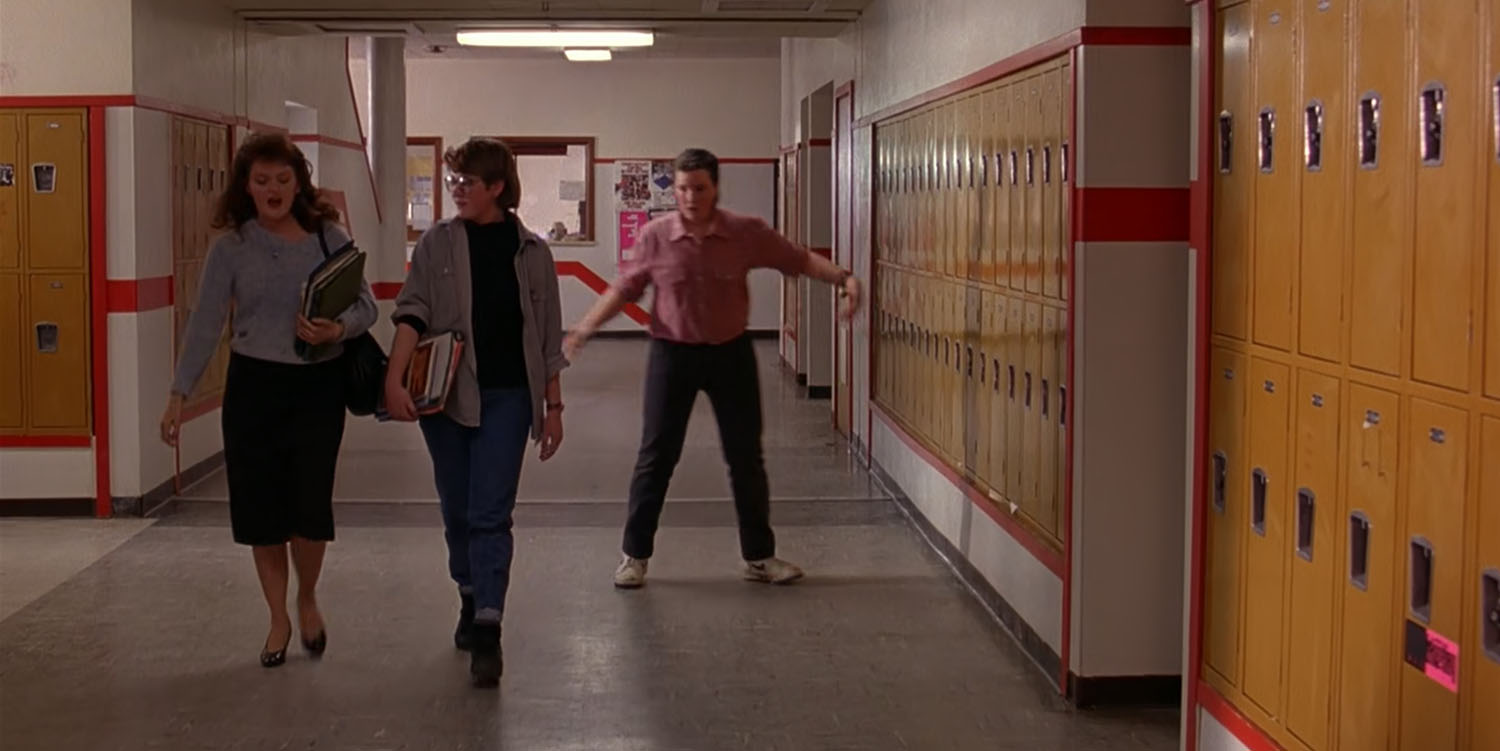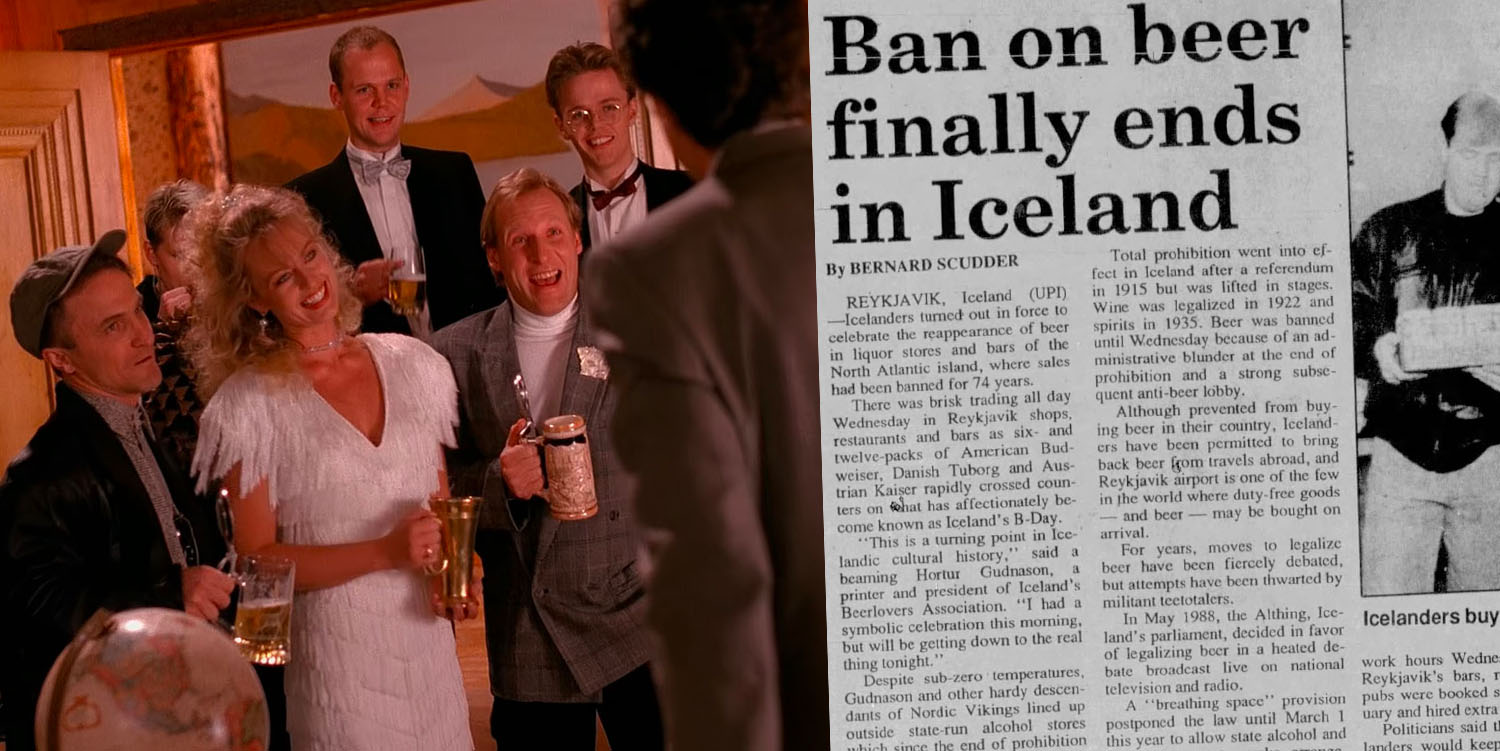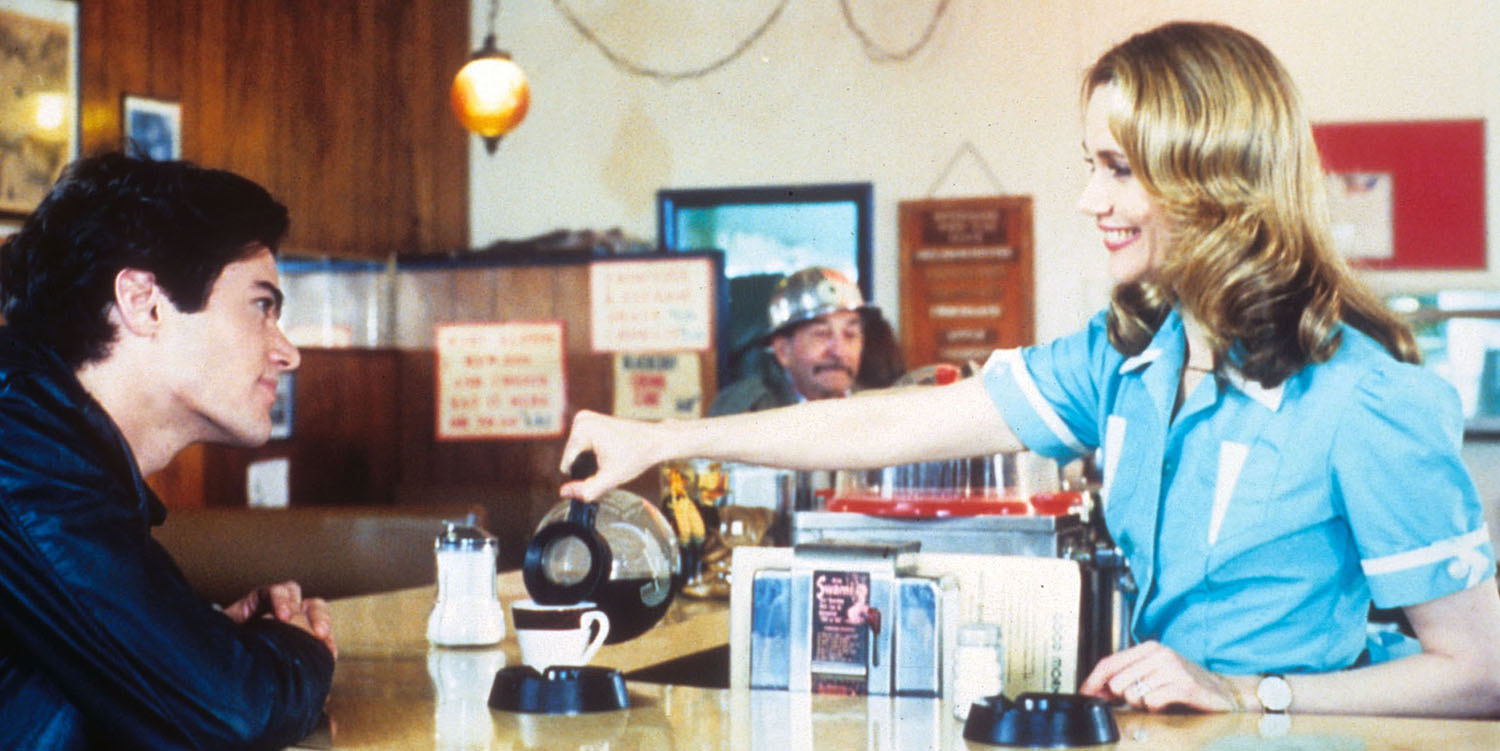Since launching Twin Peaks Blog in February 2018, I’ve enjoyed exploring the origins of Twin Peaks lore by providing well-researched and fact-based articles. In May 2021, Dugpa and I dug into the history of Twin Peaks: Fire Walk With Me at the Cannes Film Festival, helping clarify long-held misconceptions about the film’s initial reception. Channeling that same energy, I’m taking an in-depth look at how David Lynch and Mark Frost pitched Twin Peaks to ABC Television in spring and summer 1988. Using newspaper articles and interviews with the show’s creators, I’ve pieced together how the show once known as “Northwest Passage” became the wonderful and strange town fans around the world love today.
One important note about this research – I did not have access to original production documents or company memos about the original pitches. I dream of gaining access to such documents to create a definitive history one day.
This article, however, is shaped through interviews with Mark, David and others involved with the production. Interviews from the late 1980s were a great resource as the memories were fresh. With the passage of time, stories have become either hazy or embellished. Brad Dukes’ “Reflections: An Oral History of Twin Peaks” from 2014 was also an invaluable resource (you should have this book in your home library), as well as Newspapers.com, which has long been an important part my research for Twin Peaks Blog.
This part of the story picks up after Mark and David met in spring 1986.
By 1988, Frost had worked on an unproduced film based on Goddess, which was Anthony Summers’s 1985 biography about Marilyn Monroe. Frost wrote a first draft with Venus Descending used as a tentative title.
Lynch read that draft and said, “Let’s turn it in and go make the movie.” (David Bushman’s “Conversations with Mark Frost,” page 21). But United Artists walked from the idea and the film went nowhere (that is until Netflix released the documentary, “The Mystery of Marilyn Monroe: The Unheard Tapes” in 2022 which was based on Summers’s 1985 book).
Lynch and Frost, however, worked together on the unproduced One Saliva Bubble. This body-switch comedy may have starred Steve Martin and Martin Short. But it was never been produced.
They also had an idea for NBC television called The Lemurians. According to Bushman’s book the show was described by Frost as “pretty out there; it made Twin Peaks look like Peyton Place” (“Conversations,” page 99). While a script was not drafted, a three or four page high-level idea was pitched. NBC declined.
WHEN WAS THE FIRST PITCH MEETING TO ABC TELEVISION ABOUT “TWIN PEAKS?”
The story of how Frost and Lynch came up with the idea for Northwest Passage (the original name of the show before it became Twin Peaks) is a completely different article. So we’ll skip ahead to when the duo had an initial meeting with ABC Television executives at the suggestion of Tony Krantz. He was an agent with Creative Artists Agency (CAA) who had suggested David and Mark get together to work on a television show.
According to Mark Frost’s interview with Terry Gross for Fresh Air on October 18, 1989, Tony thought he had a unique opportunity with ABC that would allow them to create the kind of show they wanted.
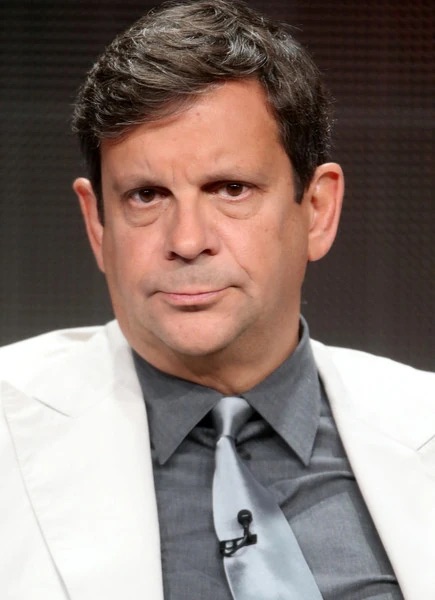
“We have a very persistent mutual agent by the name of Tony Krantz, who kept insisting that the two of us should should try our hand at television. And I’d, you know, done [television] before and had a great time doing it, but I was it sort of had my fill. And Tony said, ‘I can create a situation for you where you can sort of control the show and and do kind of what you want.’ And let’s go in and have a meeting about it.”
In the mid-1980s, ABC had a reputation for being overly controlling and directive on its network shows. Krantz must have felt change in the air which prompted this meeting.
Mark would later explain during a Twin Cities PBS broadcast called Inside Twin Peaks on October 6, 1990 that they met with ABC at the perfect time.
“I think we went into the ABC offices at exactly the right moment,” said Frost. “They had a disappointing season prior to that and were looking at declining numbers for the fourth straight year at the time. And they were really ready to take a chance, to do something different. And they heard our idea.”
Like so many things that are doubled in Twin Peaks, the meeting with ABC was the first of two pitch meetings.
The first meeting, according to David Lynch and Kristine McKenna’s “Room to Dream,” was held in March 1988 (p. 247). By this time, Frost said, they had been, “kicking around this idea about a small town and without really even knowing who the people in the town were or what the story was” (Fresh Air, Oct. 18, 1989).
But when was this meeting held in March?
From my research, it must have been held during the first week March, potentially between February 29 to March 4.
Why those dates? A prolonged strike by the Writers Guild of America began on Monday, March 7.
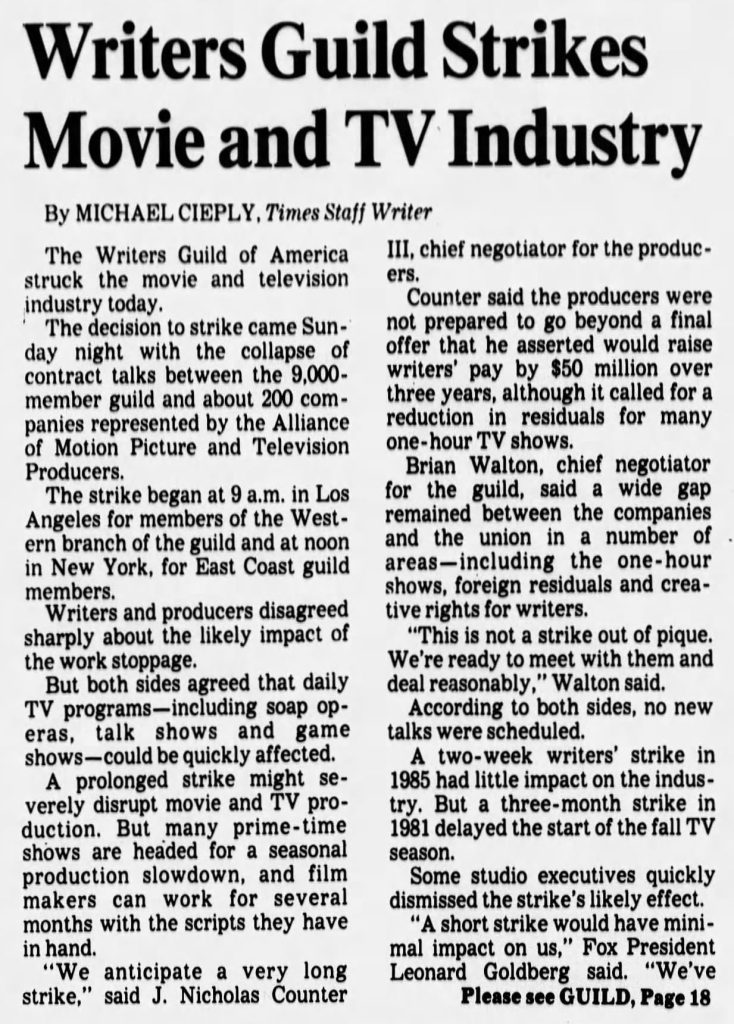
The Guild decided to strike on Sunday night, March 6, after contract talks collapsed between its 9,000 members and the 200 companies represented by the Alliance of Motion Picture and Television Producers. The strike began at 9:00 a.m. on Monday for West Coast members and noon for East Coast members, and would last well into the summer. Follow up conversations with ABC were inevitably delayed.
HOW WAS LYNCH AND FROST’S FIRST PITCH RECEIVED BY ABC TELEVISION EXECUTIVES?
Krantz arranged a “how-do-you-do meeting” for Lynch and Frost with ABC Executives. According to Frost in “A Room to Dream,” this meeting included Vice President of dramatic series development, Chad Hoffman (p.247). There may have been others present such as Gary Levine, who served as Vice President of ABC Drama Development from 1988-1992, but I’ve been unable to confirm the attendee list.
One person who was not in the room was Brandon Stoddard, promoted to run the network on November 12, 1985 by then new owners of ABC, Capital Cities, Inc. He confirmed in Dukes’ book that he was not present at the first meeting. (“Reflections,” page 10)
“You’re the only guy brave and crazy enough in town to do this,” said Tony Krantz to Hoffman via a phone call when arranging that first pitch meeting. “I want you to meet with David Lynch and Mark Frost.” (“Reflections,” page 8).
He agreed.
“Sure, bring ’em in. Why not?,” replied Hoffman who was keen on trying things that other people would not try. (“Reflections,” page 8).
Most likely this meeting was held at the former ABC Entertainment Center, once located at 2040 Avenue of the Stars in Century City.
This West Coast headquarters for ABC Television opened in 1972. The network would continue occupying the building until late 2000 when they relocated to the ABC Building on the Walt Disney Studios lot in Burbank, California.
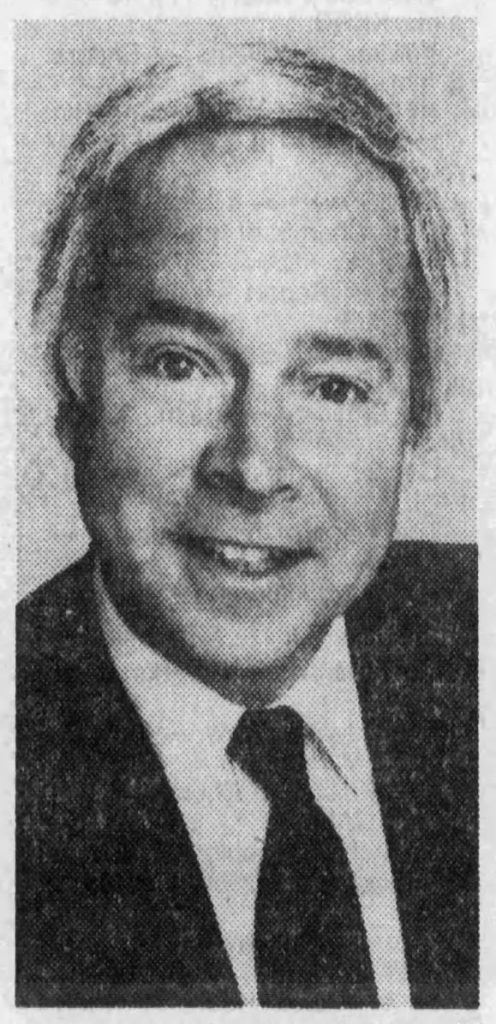
Hoffman and other executives were tasked with fulfilling Stoddard’s vision for “Alphabet Network,” which Stoddard explained to Brad Dukes.
“We were trying to change – not the image – but the programming of ABC and we were trying to make it a little more adult, a little bit more serious and improve the writing and productions, etc.” (“Reflections,” page 7)
Hoffman continued in Dukes’ book.
“When Brandon took over the network he brought in a bunch of us, ostensibly to take the network (which at that the time was in third place and probably losing money if memory serves me correctly) and to really alter the programming style and really give it a sense of purpose and meaning for a viewer, and most important, an identity. The hope was that if we did that the audience would follow us.” (“Reflections,” page 7)
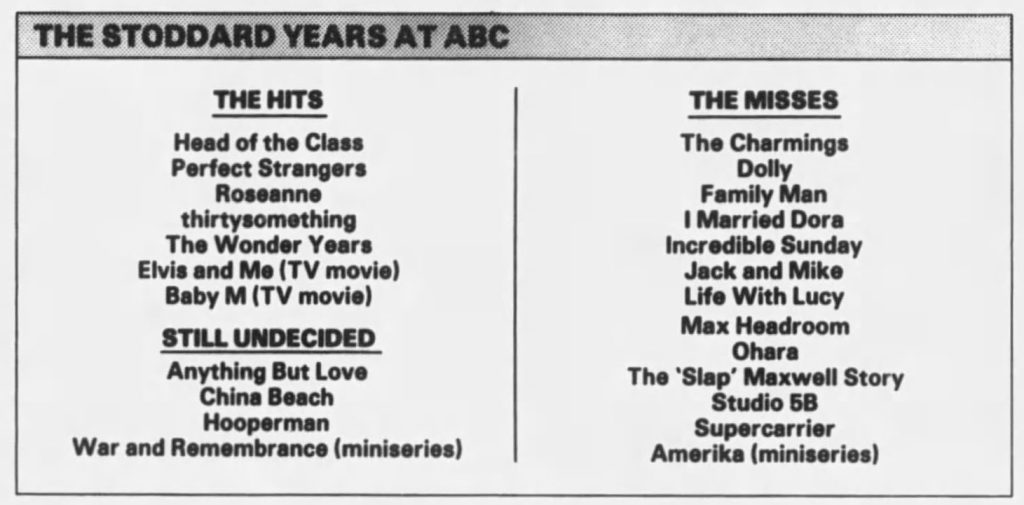
During Stoddard’s time leading ABC from 1985-1989, there were a string of hits including Perfect Strangers, Roseanne and something that Hoffman championed both China Beach and thirtysomething, while executives like Stu Bloomberg oversaw the creation of The Wonder Years, Roseanne, Coach and Home Impovement. I would add Max Headroom to the “Hit List” as I loved that show as a child.
Gary Levine spoke highly of Hoffman to Brad.
“Chad absolutely believed in finding the highest quality and the most distinctive programming, and if you build that, the audience will come. ‘Never pander to the audience and respect creators who come in.'” (“Reflections,” page 8)
Stoddard, however, surprisingly resigned his top position to lead the network’s production division on March 21, 1989, stating his work was “just no fun anymore.” Hoffman left around the same time.
If Stoddard had stayed on for one more year, Twin Peaks would have joined his “Hit List” above. Interestingly, Lynch and Frost had wrapped location production for the Twin Peaks pilot at Kiana Lodge in Poulsbo, Washington just a few days prior to Stoddard resigning.
Stoddard, who passed from cancer at the age of 77 in 2014, had been with ABC for 15 years prior to leading the organization. He also famously brought Alex Haley’s Roots to ABC and developed the ABC Afterschool Specials and Schoolhouse Rock, plus a number of miniseries and television movies like The Day After (which scared the heck out of me as a young child).
He was a big advocate for Twin Peaks and something that would later encourage his successor Bob Iger to fully support. But Iger’s support of the show is a different story for another time.

In a New York Times interview on May 21, 1990, Hoffman said the network “had a strategy to turn the network around by taking shots and being patient … It was basically what NBC had done to pull itself up in the early 80’s.”
“We had our initial meeting with ABC and the meeting went very well,” remarked Frost during his Oct. 18 Fresh Air interview. “They were, I think, mystified but intrigued by what we were talking about.”
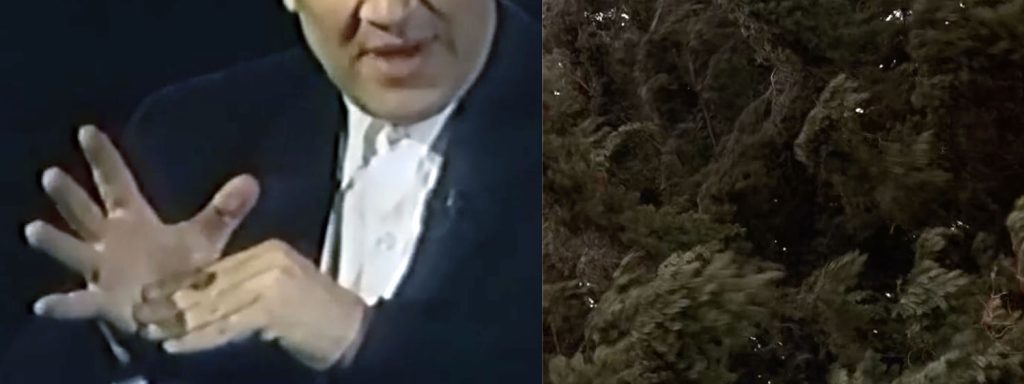
In Mark Altman’s “Twin Peaks: Behind the Scenes” (1990), the meeting allegedly “lasted ten minutes.”
“We talked about the show for an awfully long time,” said Frost. “We went in and met with this adventurous ABC executive [Chad Hoffman] who had approved China Beach and thirtysomething. We said we had this idea for the show and there’s this wind and there’s a lot of people and something bad happens, we didn’t know what yet.” (page. 18)
For “Reflections,” Mark gave some additional context from the initial pitch:
“We didn’t have a whole lot to say in that first meeting,” Frost reminisced. “Literally that story David has told, ‘There’s this town and this wind…” and he made the gesture with his hands, “and then there’s a dead girl and then a whole bunch of stuff happens.’ It wasn’t that simplistic [laughs] but it wasn’t too far from that. Chad [Hoffman] was caught like a trout on a hook. He thought it was the coolest thing that he’d ever heard and no one was more surprised they wanted it than we were.” (“Reflections,” page 10)
Frost would later echo comments about Lynch’s hands and the wind n a 2017 interview for Little White Lies that Lynch spent “the majority of their meeting describing – with suitably jazzy hand gestures – the way the wind whispered in the pine forests surrounding the town.”
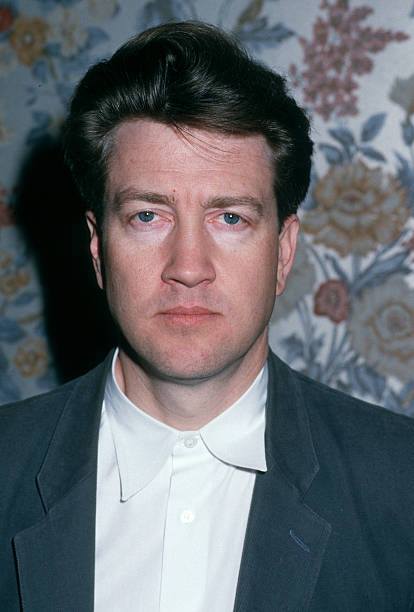
Hoffman was indeed hooked; he loved the pitch.
“They came in and talked generally about the kind of show that they wanted to do,” remembering the pitch to Brad Dukes. “They talked about a real sense of mood of this town in the Northwest where everything was pristine and beautiful, but that behind the curtains was a world with the lives of people that were quite opposite of the environment that they lived in. It was all about secrets and I remember David and Mark talking about what you see in the foreground is not what’s going on in the background and what’s going on in the background is what’s going to capture everybody.”
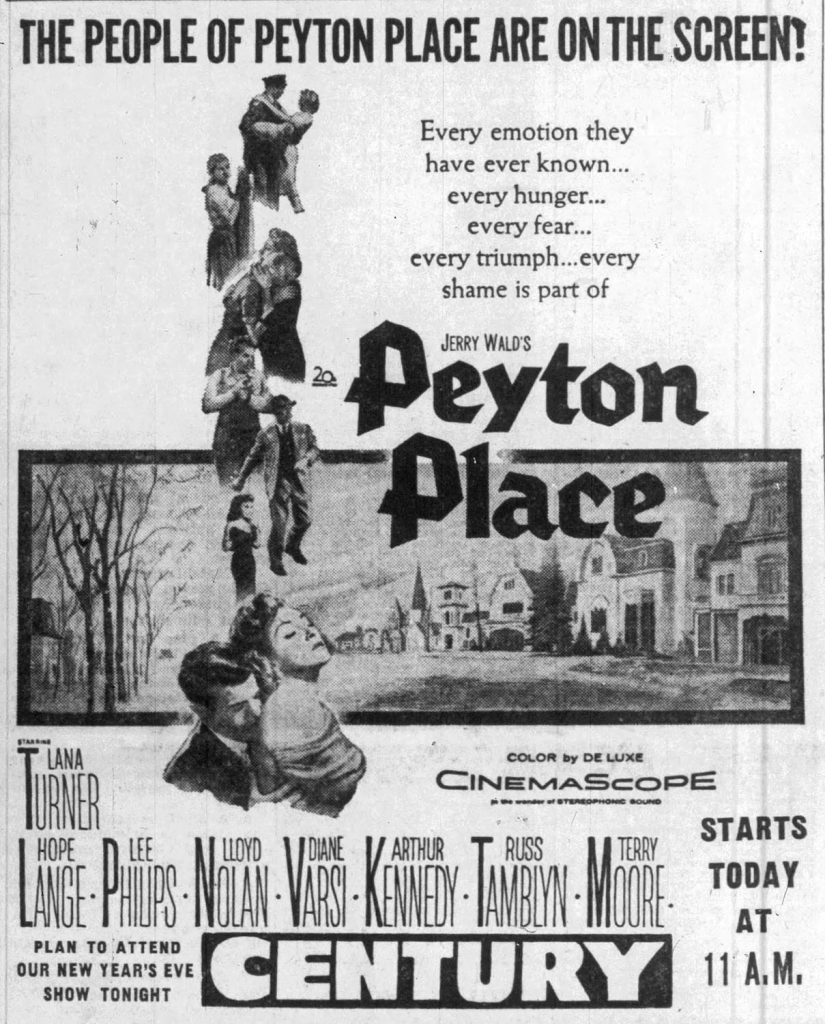
At the end of the meeting, Hoffman recapped the conversation and gave the filmmakers some homework.
“I think you’re talking about something that kind of has the feel – for wont of a better TV term – sort of a soap opera, but not in a negative sense,” explained Hoffman in “Reflections.” “Why don’t you go back and take a look at Peyton Place (the movie, not the series) and think about that piece with the quaint town and what was going on behind the scenes and just think about how something like that was done; [it] might jive with what you’re trying to do and see if there’s a connection there. If there is, come back because I’m very interested.” (“Reflections,” page 11)
“And they all kind of leaned forward,” continued Mark in Charles de Lauzirika’s “Secrets From Another Place: Creating Twin Peaks” 2007 documentary found on Disc 10 of the Twin Peaks Definitive Gold Box Edition DVD set. “And I kind of knew we had them. So sure enough, they made it as an offer to write this pilot. And a few weeks after that, the Writers Guild went on strike. So it fell into the cracks. And that was a long, kind of acrimonious strike.”
“Because of the strike, everything got put on hold for almost a year, so there was a hiatus after that first meeting at ABC,” remembered Frost during a conversation with Kristine McKenna that she conducted on July 12, 2016 for “Room to Dream.”
If they met with ABC a “few weeks” (or a “year”) before the strike, this means that either the March 1988 date in “A Room to Dream” is incorrect or the two pitch meetings were merged into one. My gut tells me that memories were merged – Lynch and Frost really did meet with ABC in March 1988.
This is one of the times I wish I had actual production paperwork or an appointment book from ABC Television, Mark Frost or David Lynch. Folks, however, may not have written this kind of stuff down.
THE WRITERS GUILD STRIKE OF SUMMER 1988
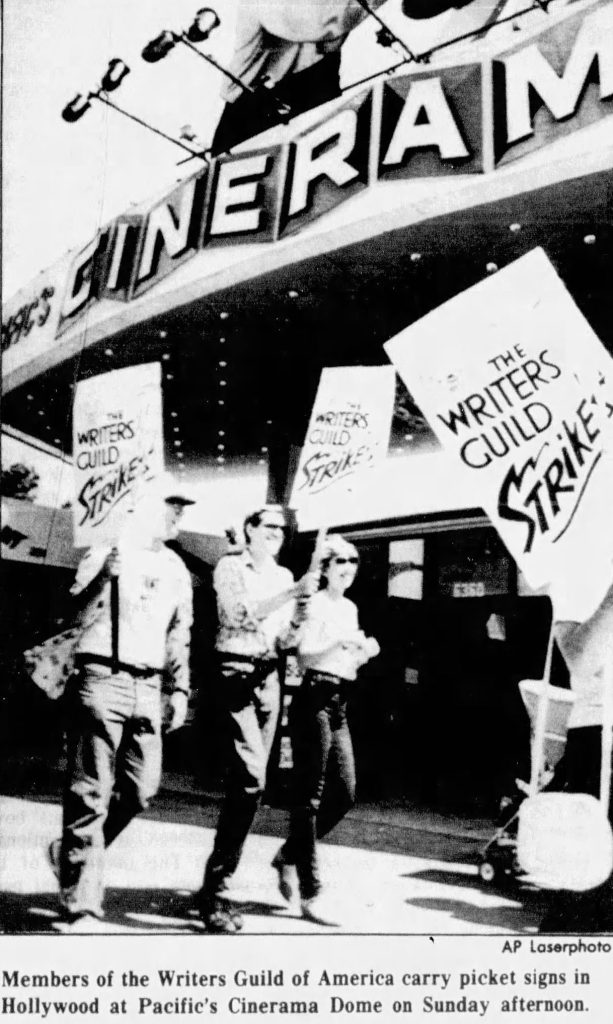
One thing is certain, the Writers Guild strike in summer 1988 delayed the second pitch meeting with ABC, Lynch and Frost.
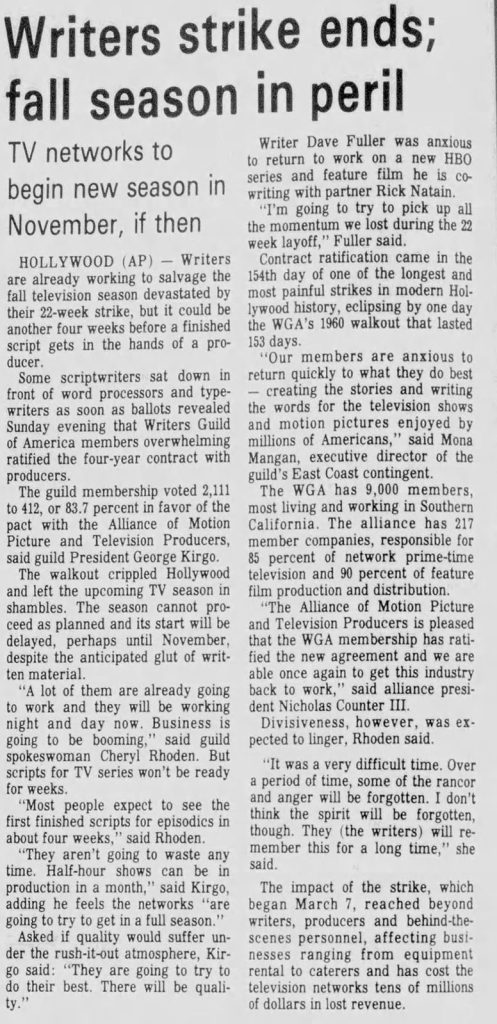
The 22-week strike ended on August 7, 1988 which resulted in a new four-year contract for Guild writers. At 154 days, it was the longest strike since 1960 walkout that lasted 153 days. By comparison, the 2023 strike was 148 days.
The 1988 strike delayed the start of fall programming until October and November versus the traditional September start.
Meanwhile as work resumed in Hollywood, Tony Krantz called Mark Frost and said ABC wanted to meet and discuss their idea from the March pitch meeting.
“We really had to sit down and ask each other, what did we tell them?” laughed Mark. “Because I didn’t have any real memory of what they bought. So we developed it a little further and went back in. And that led to the first draft.” (“Secrets From Another Place: Creating Twin Peaks”)
Frost would expand on this story for McKenna’s “Room to Dream”:
“When the strike ended they called and said, ‘We want to proceed with that project you pitched,’ but by that point neither of us could remember much of what we’d said! So we talked about it some more, then met with them and were told to go write. We knew it was going to be some kind of serial about the murder of a homecoming queen, and the first image we had was of a dead body washing up on the shore of a lake.” (Page 247)
At some point after August 7, Tony Krantz called Hoffman and said, “[Lynch and Frost] are ready to talk.”
WHEN WAS THE SECOND PITCH MEETING TO ABC TELEVISION ABOUT “TWIN PEAKS?”
So when was the second pitch meeting? Mark Frost told Terry Gross during a Fresh Air interview on October 18, 1989, “And we came back a few months later after the writer strike ended and sat down and a week later we were writing the script.”
But Gary Levine has the definitive answer thanks to a saved memo.
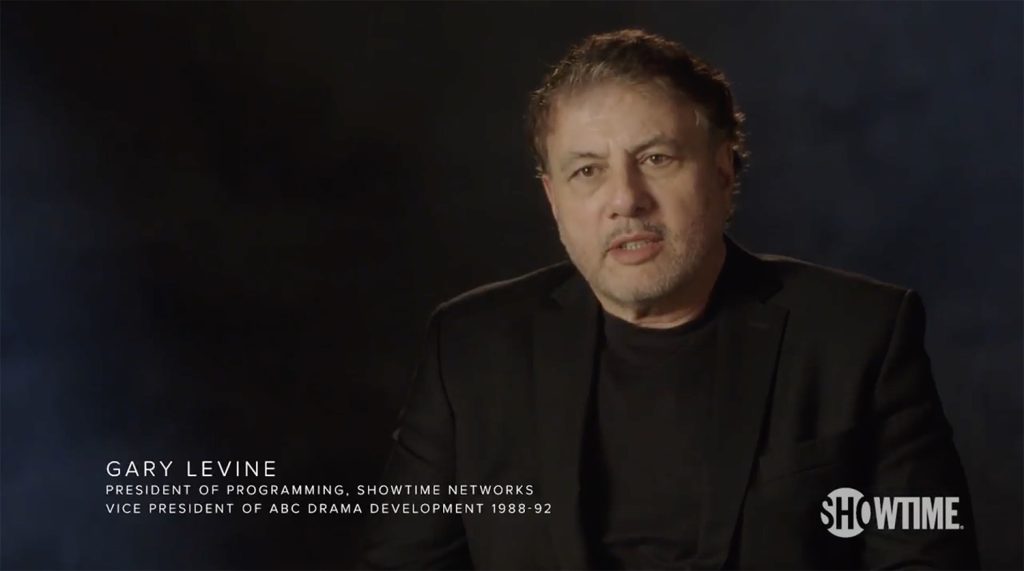
According to Maureen Ryan’s article for Variety.com on May 9, 2017 titled, “Inside the Roller-Coaster Journey to Get David Lynch’s ‘Twin Peaks’ Back on TV,” Levine was one of the executives who heard Lynch and Frost’s pitch for the then-titled “Northwest Passage.” He still has the memo noting the date of the first concept meeting for the pilot as Thursday, August 25, 1988.
Gary would later serve as President of Programming for Showtime Networks and played an instrumental role in making the third season of Twin Peaks, known as “The Return,” happen.
THE SECOND PITCH MEETING FOR “TWIN PEAKS” WITH ABC EXECUTIVES
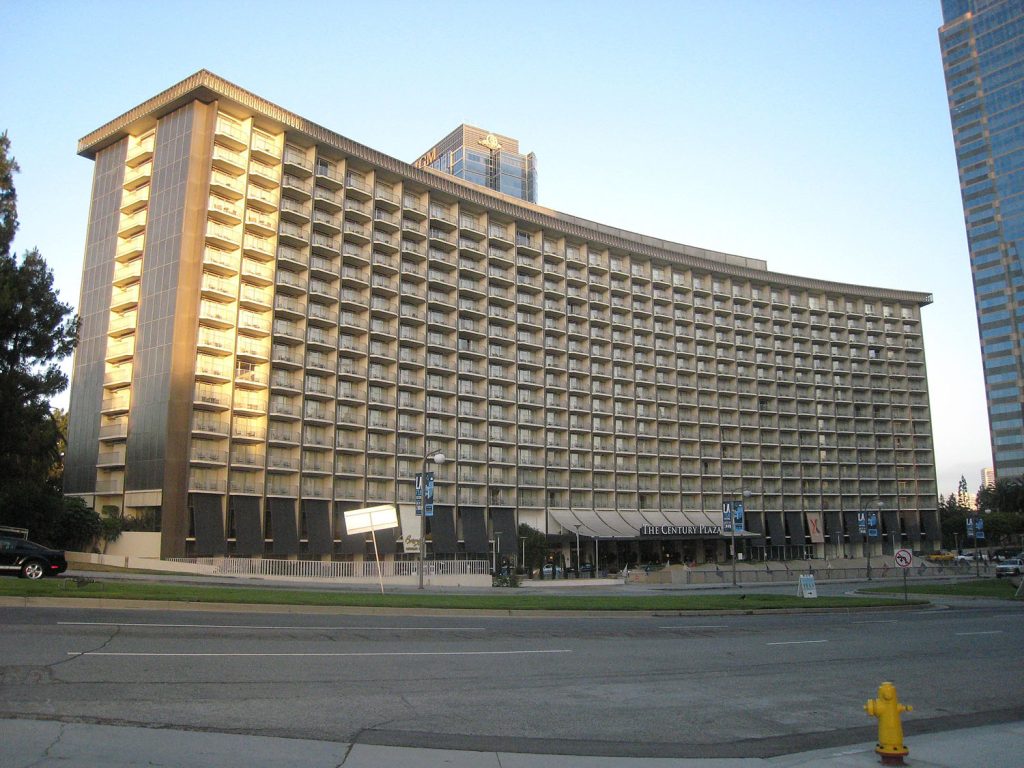
Hoffman arranged for breakfast at Café Plaza in the former Century Plaza Hotel, located at 2025 Avenue of the Stars in Los Angeles, California.
This historic 19-story hotel opened in 1966 and was the site for numerous Hollywood events and political gatherings. It was also the first hotel to have color televisions in all of its rooms.
Japanese-American architect Minoru Yamasaki, who was born in Seattle, Washington, designed this stunning hotel whose doormen once wore Beefeater outfits. Yamasaki also designed the first World Trade Center in New York City.
The hotel closed on March 1, 2016 to begin a $2.5 billion overhaul which added two towers above the original hotel complex. Today it’s known as the Fairmont Century Plaza hotel.
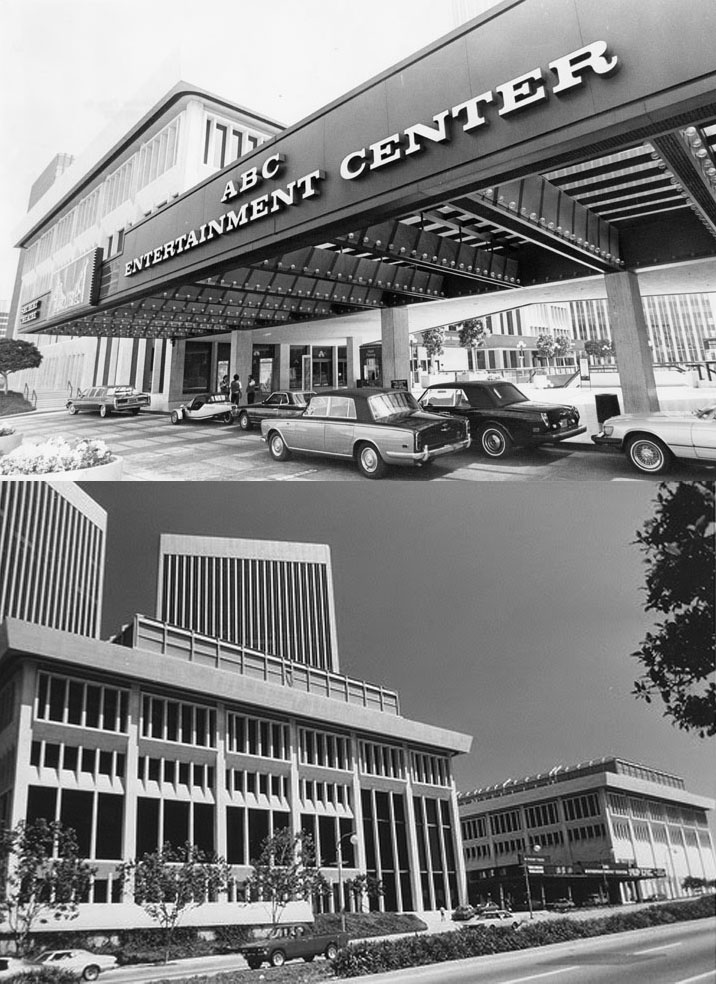
The hotel was conveniently located behind the previously mentioned ABC Entertainment Center, once located at 2040 Avenue of the Stars, where Hoffman, Levine, Stoddard and many other ABC employees worked.
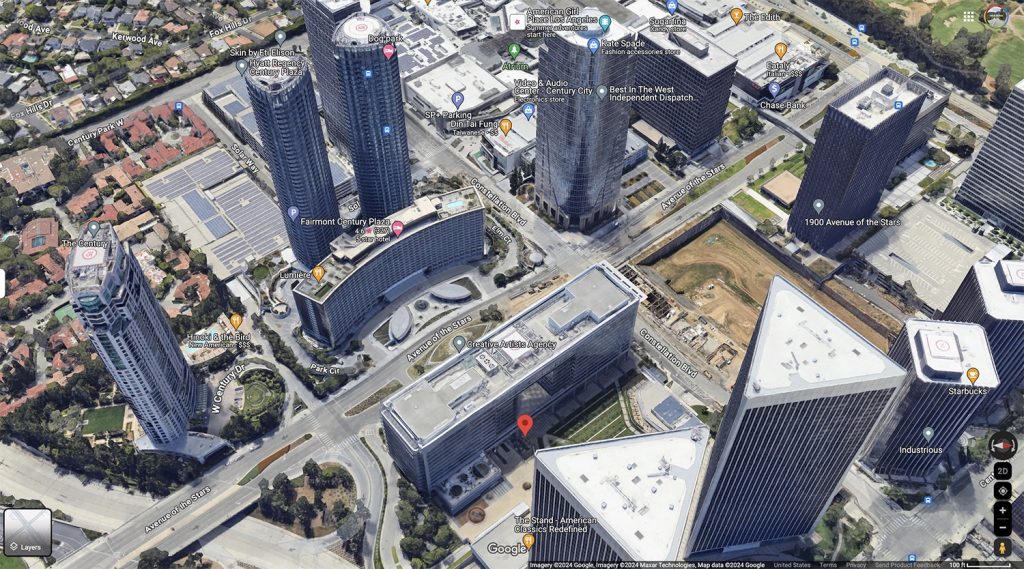
You can see it was literally across the street from the ABC complex (red dot on map).
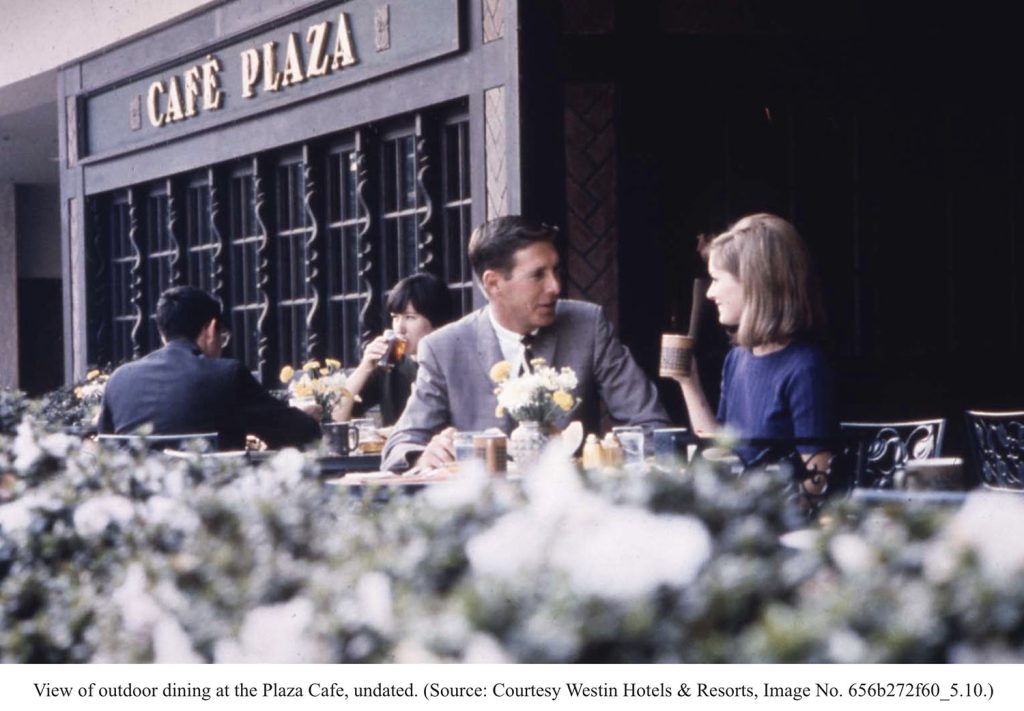
The informal Café Plaza was located on the Plaza level of the hotel, one floor below lobby level. A popular meeting spot, it was remodeled in 1983 (so it probably looked different than the image above).
Lynch recalled a story in Chris Rodley’s “Lynch On Lynch” about the morning on the way to breakfast with Hoffman, Levine, and Krantz.
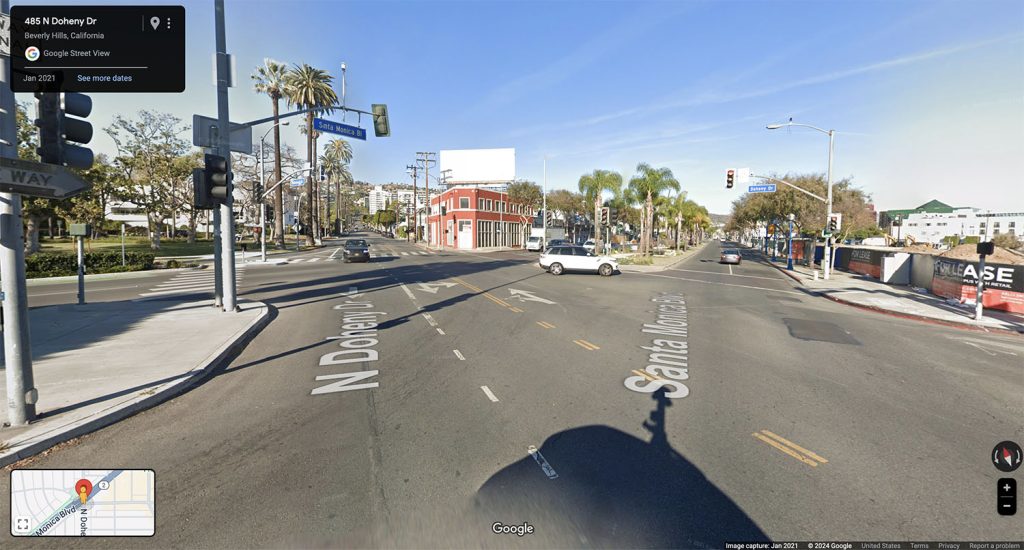
“Well, on the way to ABC to pitch Twin Peaks, Mark picked me up and we drove down Melrose,” said Lynch. “I look at license plates of cars. I started doing it before Eraserhead. I was driving down Sunset Boulevard and there was a really beat-up Volkswagen in front of me, but it had my initials, DKL, and some numbers. And this struck me as a good omen.
So I developed this thing where if you see your initials in any order, that’s good. (There’s very little bad in this thing!) And if the numbers add up to a good number for you, that’s even better! And if the car itself is a really good car for you — that’s even better! So the ultimate would be your initials in the correct order, a number that adds up to one that you like, and a car that’s good. OK.
So Mark and I were turning onto Santa Monica Boulevard, just before Doheny, and coming around the corner was this brand new, white Mercedes. And it had my initials on it and a good number! And I said, `Mark, this is going to be very good!'” (“Lynch on Lynch,” page 158)
David and Mark arrived and made the pitch.
“We didn’t approach it as a television show,” says Frost in Cyrus Shahrad’s “Who Killed Twin Peaks?” article for Little White Lies on February 22, 2017. “Remember that we were coming out of a decade in which the tone of major television was set by shows like Dallas, shows that David and I wouldn’t be caught dead watching. It felt like we’d been led into the big machine inside a Trojan horse, and that seemed all the more reason to make Twin Peaks as strange and subversive as we possibly could.”
Rodley asked Lynch about the pitch for his 1997 book – “What exactly was your pitch to ABC?”
“The mystery of who killed Laura Palmer was the foreground,” answered Lynch. “But this would recede slightly as you got to know the other people in the town and the problems they were having. And each week would feature close-ups of some things. The project was to mix a police investigation with the ordinary lives of the characters. We had drawn a map of the town. We knew where everything was located and that helped us determine the prevailing atmosphere and what might happen there. I guess what made Twin Peaks. Twin Peaks is hard to talk about. I don’t think we even knew what it was. But ABC said they wanted to do the pilot.” (“Lynch on Lynch,” page 158)
Hoffman was captivated by the dreamers’ story.
“We had a great breakfast and they talked about the town where everybody lived and they talked about how all the stories interconnected and it was just captivating.” (“Reflections,” page 11)
DAVID LYNCH’S CHARCOAL MAP OF TWIN PEAKS
During my research, I discovered there was a map shown during the second pitch meeting. Recollections of when the map was created and shown are conflicting.
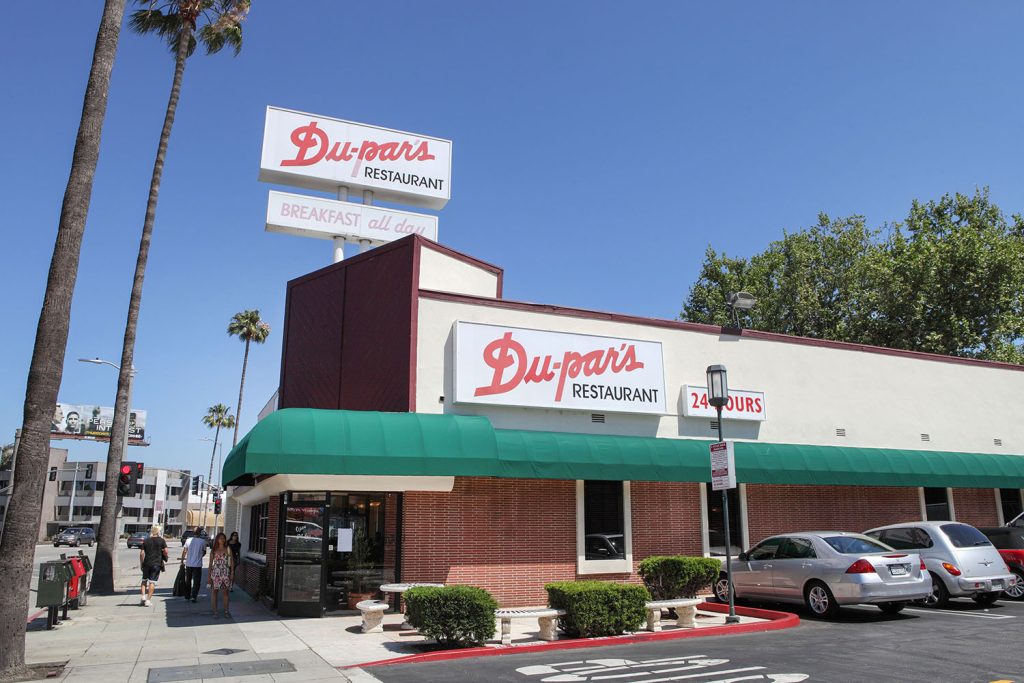
Frost shared a story about the creation of the map in Bushman’s “Conversations with Mark Frost.”
“…I can vividly remember having this lunch at Du-par’s where we drew a map of the town. We were trying to think of a title, and David was writing on the back of a placemat. I was describing what I was seeing, and he was translating it into a map. ‘There’s a mountain here’ and ‘There’s a mountain there.’ We were naming thing and the town was in between – a valley and a river, a waterfall and a lake. We we looked at the map after we finished it and I saw these two big mountains, the title Twin Peaks came to mind. I can’t remember which of us said it first, but as soon as one of [us] did, it was ‘Well, OK, that’s it.” (“Conversations,” pages 114-115)
This placemat map may have been an early draft of the map before the more famous charcoal version of the map was created.
Lynch also shared a memory from Du-par’s where the central image that became Laura Palmer washed up on the shore of a lake was conceived.
“So one day Mark and I were talking at Du Pars [sic], the coffee shop on the corner of Laurel Canyon and Ventura, and all of a sudden, Mark and I had this image of a body washing up on the shore of a lake.” (“Lynch on Lynch,” page 157)
Lynch continued answering Rodley.
“That’s how it came to pass [Laughs]. Originally it was called ‘Northwest Passage,’ a story which took place in a small town in North Dakota.” (“Lynch on Lynch,” page 157)
Most likely, Frost and Lynch met at Du-par’s to work out more details of the story before attending the second pitch meeting on August 25. They probably also drew the placemat map to help illustrate the how the story details connected to the “whole damn town.”
I’ll dig deeper in a separate article about Lynch and Frost’s story inspiration and writing of the actual script (it too has conflicting accounts and hazy memories).
Sadly, Du-par’s Restaurant, once located at 12036 Ventura Blvd Studio City, California, closed in December 2017 and is now a Sephora.
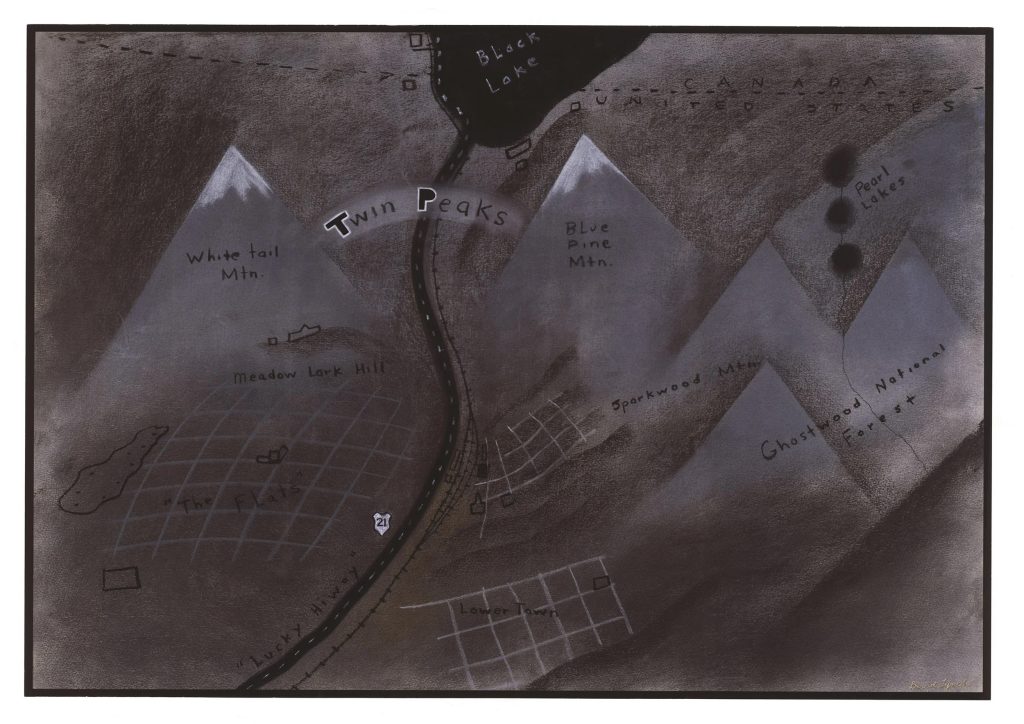
David’s charcoal map map named several places that would eventually become part of the show – Ghostwood National Forest, White Tail Mountain, Blue Pin Mountain, Black Lake, Highway 21, Pearl Lakes. Other names were not heard in the series such as Lucky Hiway [sic], The Flats, Meadowlark Hill or Sparkwood Mountain.
The name Lower Town would become Lotown (“There was a Lydecker assaulted three days ago outside a bar in Lotown,” said Sheriff Truman in episode 1.004).
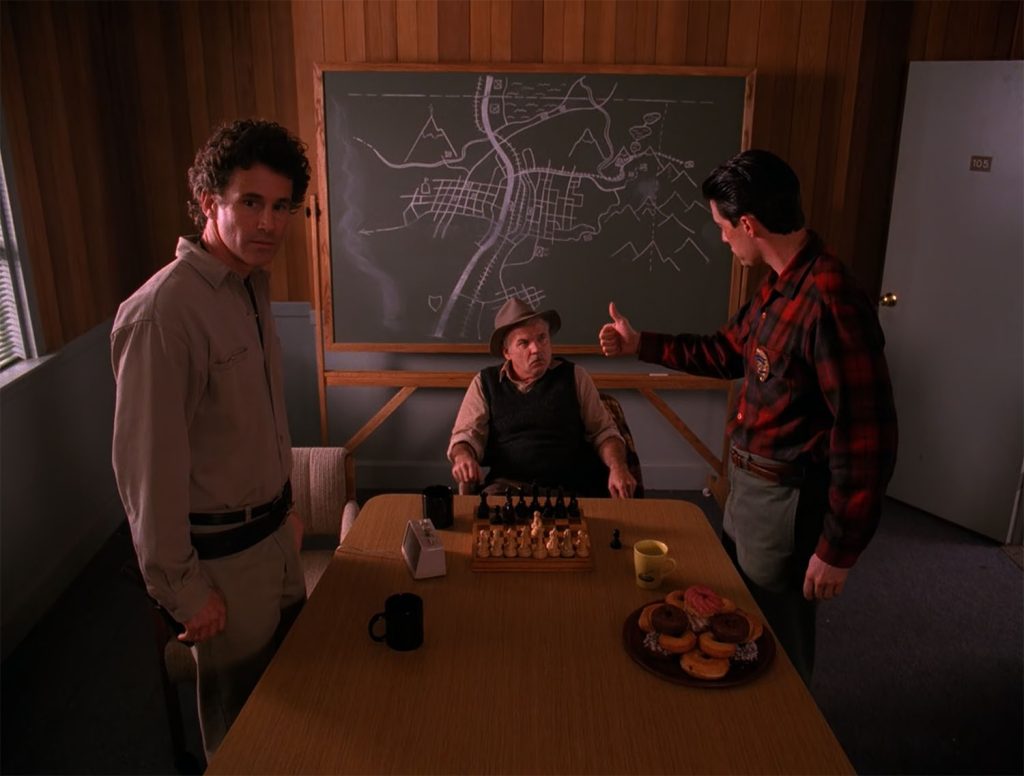
Nevertheless, the basic town layout from that original charcoal map would evolve into a similar map as seen in the Twin Peaks Sheriff’s Department during episode 2.016.
Krantz recalls David and Mark “unfurling the charcoal map” during the breakfast meeting with Chad and Gary. In this case, the placemat map could have been the original which Lynch reworked into the charcoal version before that pitch meeting.
In “Room to Dream,” author McKenna says Lynch and Frost took the charcoal map with them when they turned in the script and “referred to it as they described the world they were evoking in the script.” (“Room to Dream,” page 248). This would have happened after the second pitch meeting.
Lynch would later give Tony that charcoal map as a birthday gift, who framed it and hung it in his office.
As an aside, in fall 2023, Harvard University displayed the charcoal map and 29 other fictional maps in the first floor corridor of Pusey Library for an exhibit titled “From Academieland to Zelda.”
” LET’S DO IT”

“At the end of the breakfast I said, ‘Let’s do it.’ So we hired them to go ahead and write the script,” Hoffman continued. (“Reflections,” page 11)
Walking back to the ABC Entertainment Center, Chad said to Gary, “I don’t know if this is going to work or not, but it’s not going to be boring. It’s going to be really interesting. So we’ll take the shot.” (“Reflections,” page 12)
Krantz must have known that ABC was going to take a chance on these two creatives and give them, as he suggested to Frost, the creative freedom to make the show they wanted.
“We didn’t really want to do it unless we got carte blanche because what we had sort of envisioned doing was so different than anything else we’d see that that for us was and important part of the agreement to go ahead with this thing,” said Frost during Inside Twin Peaks on October 6, 1990.
After receiving the initial green light from Hoffman and Levine, it was full speed ahead into the wonderful and strange town.
Discover more from TWIN PEAKS BLOG
Subscribe to get the latest posts sent to your email.

